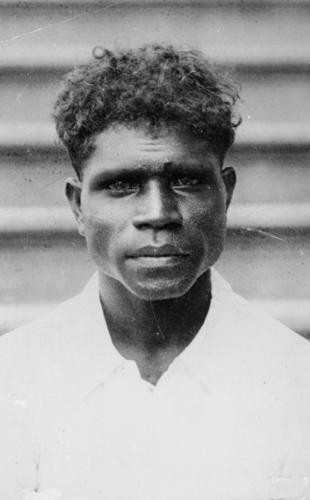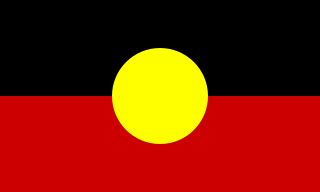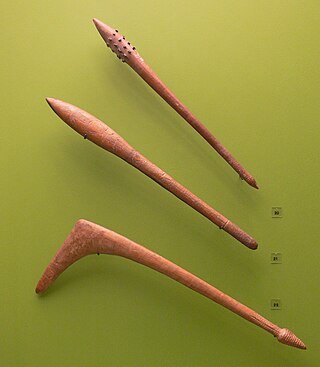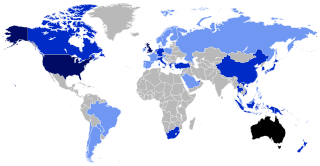Related Research Articles
Aborigine, aborigine or aboriginal may refer to:

In 1868, a cricket team composed of Aboriginal Australians toured England between May and October of that year, being the first organised group of Australian sportspeople to travel overseas. It would be another ten years before an Australian cricket team classed as representative left the country.
Australian Aboriginal English is a cover term used for the complex, rule-governed varieties of English used by a large section of the Indigenous Australian population as a result of colonisation. It is made up of a number of varieties which developed differently in different parts of Australia, and grammar and pronunciation differs from that of standard Australian English, along a continuum. Some of its words have also been adopted into standard or colloquial Australian English.

Harold Edward Gilbert, known as Eddie Gilbert, was an Australian Aboriginal cricketer who represented Queensland in the Sheffield Shield. He was described as an exceptionally fast bowler. He competed for Queensland in the Sheffield Shield between 1930 and 1936. Described by Don Bradman as the fastest bowler he ever faced, Bradman said he was “faster than anything seen from Harold Larwood or anyone else.”

Ashley Alexander Mallett was an Australian cricketer who played in 38 Tests and 9 One Day Internationals between 1968 and 1980. Until Nathan Lyon, he was Australia's most successful off spin bowler since World War II. He extracted a lot of bounce from his high arm action, coupled with his height. He was a part of the Australian squad which finished as runners-up at the 1975 Cricket World Cup.
Australian Kriol is an English-based creole language that developed from a pidgin used initially in the region of Sydney and Newcastle in New South Wales, Australia, in the early days of European colonisation. Later, it was spoken by groups further west and north. The pidgin died out in most parts of the country, except in the Northern Territory, where the contact between European settlers, the Chinese and other Asians, and the Aboriginal Australians in the northern regions has maintained a vibrant use of the language, which is spoken by about 30,000 people. Despite its similarities to English in vocabulary, it has a distinct syntactic structure and grammar. It is a language in its own right and is distinct from Torres Strait Creole.

Aboriginal Australians are the various Indigenous peoples of the Australian mainland and many of its islands, excluding the ethnically distinct people of the Torres Strait Islands.

A scarred tree or scar tree, also known as a canoe tree and shield tree, is a tree which has had bark removed by Aboriginal Australians for the creation of bark canoes, shelters, weapons such as shields, tools, traps, containers or other artefacts. Carved trees are created as a form of artistic and spiritual expression by some Aboriginal peoples, to mark sites of significance such as burial sites.

Australian Aboriginal artefacts include a variety of cultural artefacts used by Aboriginal Australians. Most Aboriginal artefacts were multi-purpose and could be used for a variety of different occupations. Spears, clubs, boomerangs and shields were used generally as weapons for hunting and in warfare. Watercraft technology artefacts in the form of dugout and bark canoes were used for transport and for fishing. Stone artefacts include cutting tools and grinding stones to hunt and make food. Coolamons and carriers such as dillybags, allowed Aboriginal peoples to carry water, food and cradle babies. Message sticks were used for communication, and ornamental artefacts for decorative and ceremonial purposes. Aboriginal children’s toys were used to both entertain and educate.
Timmy Payungka was an Aboriginal Australian artist, a Pintupi man who worked at the Papunya Tula school of painting. He was born at Parayirpilynga, near Wilkinkarra in the Pilbara region of Western Australia.

A woomera is an Australian Aboriginal wooden spear-throwing device. Similar to an atlatl, it serves as an extension of the human arm, enabling a spear to travel at a greater speed and force than possible with only the arm.

A waddy, nulla-nulla, leangle or boondi is an Aboriginal Australian hardwood club or hunting stick for use as a weapon or as a throwing stick for hunting animals. Waddy comes from the Darug people of Port Jackson, Sydney. Boondi is the Wiradjuri word for this implement. Leangle is a Djadjawurrung word for a club with a hooked striking head.

The Gweagal are a clan of the Dharawal people of Aboriginal Australians. Their descendants are traditional custodians of the southern areas of Sydney, New South Wales, Australia.

Australians, colloquially known as Aussies, are the citizens, nationals and individuals associated with the country of Australia. This connection may be residential, legal, historical or ethno-cultural. For most Australians, several of these connections exist and are collectively the source of their being Australian. Australian law does not provide for a racial or ethnic component of nationality, instead relying on citizenship as a legal status.
Indigenous Australians are people with familial heritage from, and/or recognised membership of, the various ethnic groups living within the territory of present day Australia prior to British colonisation. They consist of two distinct groups, which includes many ethnic groups: the Aboriginal Australians of the mainland and many islands, including Tasmania, and the Torres Strait Islanders of the seas between Queensland and Papua New Guinea, located in Melanesia. The term Aboriginal and Torres Strait Islander peoples or the person's specific cultural group, is often preferred, though the terms First Nations of Australia, First Peoples of Australia and First Australians are also increasingly common; 812,728 people self-identified as being of Aboriginal and/or Torres Strait Islander origin in the 2021 Australian Census, representing 3.2% of the total population of Australia. Of these Indigenous Australians, 91.4% identified as Aboriginal; 4.2% identified as Torres Strait Islander; while 4.4% identified with both groups. Since 1995, the Australian Aboriginal flag and the Torres Strait Islander flag have been official flags of Australia.
The 1973 New Zealand rugby league season was the 66th season of rugby league that had been played in New Zealand.

Scott Michael Boland is an Australian international cricketer. A right-arm fast-medium bowler, he also plays domestically for Victoria and the Melbourne Stars. In March 2019, he was named the Sheffield Shield Player of the Year by Cricket Australia. Boland is one of a handful of Indigenous Australians to be selected to play for Australia at international level and, as of December 2021, is only the second male Aboriginal player to have played Test cricket for Australia, after Jason Gillespie. He was a member of the Australian team that won the 2023 ICC World Test Championship final.

The Quandamooka people are Aboriginal Australians who live around Moreton Bay in Southeastern Queensland. They are composed of three distinct tribes, the Nunukul, the Goenpul and the Ngugi, and they live primarily on Moreton and North Stradbroke Islands, that form the eastern side of the bay. Many were pushed out of their lands when the English colonial government established a penal colony near there in 1824. Each group has its own language. A number of local food sources are utilised by the tribes.
The Girramay are an Australian Aboriginal tribe of northern Queensland.
References
- Oxford Dictionary of English, 2nd Edition Revised
- Aboriginal Words in Australian English, Hiroyuki Yokose, 2001.